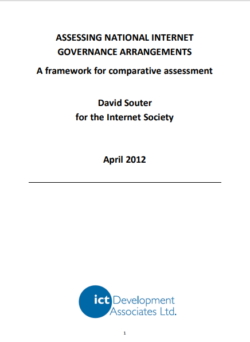This report is the first of two pieces of work by ict Development Associates (ictDA) for the Internet Society (ISOC). It proposes a framework for the assessment of national Internet governance arrangements, which can be used for comparative purposes between countries and over time, as a basis for identifying priorities for national Internet governance stakeholders, and to help ISOC’s global work to raise awareness and build capacity. A separate report from ictDA sets out findings and conclusions from a pilot study of national Internet governance arrangements in Kenya. The Kenya report provides an example of national assessments which can be undertaken using this framework, and has been used to test the methodology outlined below.
Background and context to the report
This report was commissioned by the Internet Society in response to the growing complexity and significance of the Internet governance environment as the Internet becomes increasingly widely available, enabling more services and applications to be delivered through more technologies and devices, and becoming central to the ways in which societies and economies evolve. In the six years since the end of the World Summit for the Information Society (WSIS), for example:
- the number of Internet connections worldwide is estimated to have grown from one to well over two billion, from less than 15% to more than 30% of global population;
- the number of IP addresses worldwide has surged to around 3.5 billion;
- the number of domain names in use has grown by some 8% p.a. and has reached over 200 million;
- the speed of Internet connections has accelerated as broadband networks, offering continuing growth in capacity, have been deployed globally, at national level and to end-users;
- the World Wide Web experience has been radically changed by the advent of Web 2.0 services, particularly social networking and micro-blogging applications which have shifted the emphasis of Internet use from information towards interaction;
- mobile devices have become increasingly capable of Internet access and have become predominant in extending access opportunities in developing countries;
- innovations such as cloud computing have changed the modalities for data management in ways that have potentially wide-ranging impacts on the Internet’s future development.
Growth and continual change in the Internet itself and in its economic, social and political significance have affected and continue to affect issues of Internet governance. This was defined at WSIS as:
the development and application by Governments, the private sector and civil society, in their respective roles, of shared principles, norms, rules, decision-making procedures and programmes that shape the evolution and use of the Internet.
So defined, Internet governance includes:
- issues concerned with the Internet itself – critical Internet resources such as the root server and domain name systems, the protocols and standards which govern the Internet and applications running over it, and coordination and relationships between different entities involved in making the Internet available to its users;
- the relationship between the Internet and its underlying infrastructure (in particular telecommunications networks and the regulatory and other governance processes that are concerned with them); and
- issues concerned with the use of the Internet – the ways in which it impacts on society, economy, politics, culture and individual lives.
In practice, few issues fall solely within one or other of these areas.
Just as Internet governance encompasses both technical and public policy issues, it includes governance processes and structures at global, regional and national levels. While the Internet is often described as global rather than national in character, national entities such as ccTLD registrars and IXPs feature prominently in how it is made available at national level. The ISPs and other businesses that deliver Internet access and services to end-users, and the businesses and other organisations that use the Internet to interface with the general population, are usually national rather than global and subject to national laws and regulations. Infrastructure operators are licensed nationally, though they often form part of global corporations. Governments increasingly use the Internet to deliver public services to their citizens and are concerned to understand, influence and sometimes direct the impact of the Internet on public and even private life.
One important distinction between Internet governance and most other areas of technical and public policy governance lies in the roles played by intergovernmental, governmental and non-governmental stakeholders. The development of the Internet has not been overseen by intergovernmental agencies and national governments in the same ways as, for example, telecommunications. Instead, its development has been facilitated by entities in which Internet technical professionals, private sector businesses and other non- governmental stakeholders have been at least as prominent as governments. The interaction between the Internet’s modalities of governance and more usual forms of governance varies in different national contexts.
One outcome of the World Summit on the Information Society was the establishment of an annual global Internet Governance Forum (IGF), a discussion space on Internet issues without decision-making powers. In the years since the Summit ended in 2005, a significant number of regional and national IGFs have emerged, providing similar discussion spaces at their geographic levels and an opportunity for national stakeholders to feed into the global IGF. These have been generally welcomed, but there has not yet been any systematic assessment of their role and performance.
